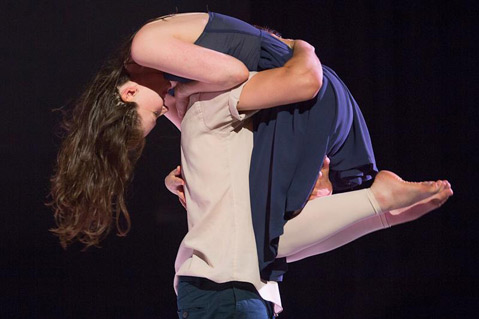A Christmas Carol at La Cumbre Junior High School
roximity Theatre Reimagines Scrooge as a Woman of the Future

In this heavily reworked adaptation of the Charles Dickens classic, the focus is on how people avoid making direct connections with one another. Set in the near future (2042, to be exact), with big chunks of new additional dialogue written by playwright and lead actress Karina Richardson, Proximity’s A Christmas Carol reimagines the cranky miser Scrooge as an uptight career woman with lots of attitude. It’s Scrooge as a mean girl — an interesting premise with the potential to open up new ways of understanding both the original text and the traditional Christmas holiday. Add to that the fact that this production is taking place in August, and you have a recipe for theatrical subversion: a promise of something radical that’s only partially fulfilled.
Trained in a wide array of traditional and nontraditional techniques at NYU’s Tisch School of the Arts and the distinguished Playwrights Horizons Theater School, the three principals of Proximity Theatre Company — Richardson, Kyra Lehman, and Ken Urbina — emphasize ensemble participation in their creative process. The most obvious result of this way of working is that each of their productions involves a unique physical vocabulary that’s developed specifically for that show. In A Christmas Carol, the company employs a gesture that mimics the way we all operate our touch-screen devices. Sitting alone and staring into space, one by one each character employs the same sequence of tap, touch, and swipe to indicate absorption in their imaginary tablets. It’s a successful capture of an important bit of modern behavior, and the actors execute it flawlessly.
The touch-screen gesture achieves its highest level of significance in a late scene where we see the Cratchit family celebrating their first Christmas together after the death of Tiny Tim. Here is where this Carol makes its most valid point: In the contemporary world, personal devices often serve as places to hide when our feelings are hurt or we are grieving, and that’s something that is unlikely to change over the next three decades.
Elsewhere, the show’s intent toward the material it appropriates is less clear. While the work of Proximity Theatre Company may share certain external resemblances to the New York avant-garde theater of the late 20th century — distancing effects, absurd dance sequences, the appropriation and deconstruction of classic texts, etc. — the tone and impact of their work could hardly be more different from that of, say, The Wooster Group. The fundamental message here, whether intentional or not, is a thorough endorsement of the status quo. As the additional material written for this show makes clear, beneath the understandable external meanness of the Scrooge persona beats the warm heart of a sympathetic figure.
As in Richardson’s earlier play, Shandy Wilkes, this show follows the travails of an attractive young woman from an upper-middle-class background as she lives a little, loves a little, and learns a little. In A Christmas Carol, the Proximity twist on the classic coming-of-age plot remains the same as it was in Shandy Wilkes: In both stories, the protagonist loses contact with others when she becomes wealthy and powerful. While this notion (is it the burden of privilege? or the exile of entitlement?) might have been the point of departure for something interesting if it were pursued with clarity, here it floats amid a flashy but ultimately forgettable set of externals. Despite the presence of all the familiar elements from the Proximity playbook — flattering costumes, sporadic displays of adolescent cleverness, and ensemble dance numbers that combine a few basic moves with cheery exhibitionism — the end result is something less than a holiday.



